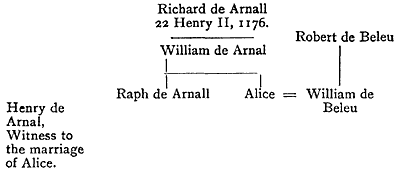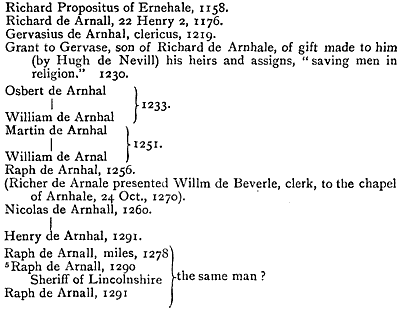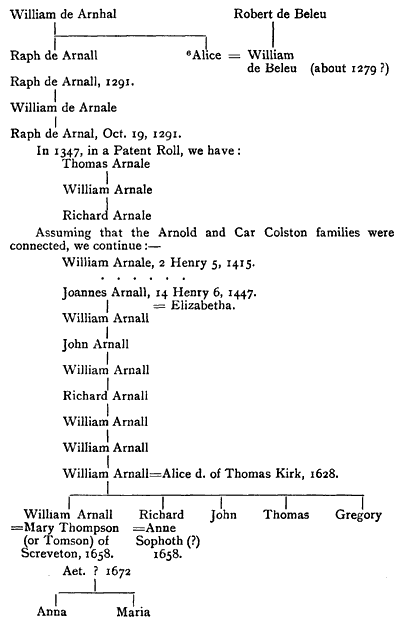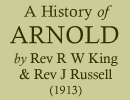< Previous | Contents | Next >
Angles.
When the Angles first came to Arnold we do not know— probably about the year 600—nor do we know its then name, but they afterwards called it Ernehale. We may be sure that the whole district was very largely overspread with woods. The new comers would find several beautiful springs rising to the west of what we call Calverton Road, and near to the foot of the hill, one being at the top of Church Lane. Round these springs, and by the streams flowing therefrom (where the main street now stands) they would clear the ground, build cabins chiefly of timber, and cultivate small strips of land, which would be gradually extended. Between the sites of the several springs they selected a spot on which they ultimately built a church, and it is pleasant to reflect that on that spot for a thousand years thanks and prayers have been offered to God for pardon and purity, peace and help, and every other blessing.
The Angles, as well as the Normans who came near upon five hundred years afterwards, cultivated their land in strips, such as may be seen in Germany, Normandy, and elsewhere on the continent to this day. There was a furrow, or "balk," between each of the strips, and all persons cultivated upon an agreed system and three years' course, so that each field might lie fallow every third year. These fields were without hedges, and were in groups. After the reign of Henry VIII, and especially since the Inclosures, hedges were put between the strips or fields. There was probably one group just above the Church, on each side of Calverton Road. There were groups on each side of Front Street, possibly now represented by long gardens, or rows of houses, reaching up to High Street, which was probably a headland. On the west of the Church is Red hill road, where is a bend that may represent one of the old headlands. As time went there were old enclosures taken out of the waste, or open lands, and cultivated in strips. Proof of this may be seen on the map of the Inclosure Award of 1791, and the groups were in Killisick Lane, Hicklings Lane, and elsewhere, where even now there are hedges to many narrow and long fields formerly cultivated as arable land, and frequently having a slight curve which ploughmen of old, as now, admired. These groups of lands would give several varieties of soils for cultivation, and each holder had strips in various fields.
The water meadows for pasture were scarce, and highly valued and under strict rules as to the number of animals allowed in the joint pasture, this often consisting of big fields. Traces of this will be found near to the stream in the southern part of the parish.
Possibly there would be a Calvary, or crucifix, at the entrance of each cultivated field, as may even now be seen in Normandy and Brittany, intended to act partly as a boundary mark, and partly to excite or suggest religious devotion.
Domesday Book.
William the Conqueror directed an account to be obtained from every part of England as to the assessable land, etc. This return was completed in 1086, and is called "Domesday Book." The following is the return with regard to Arnold, as translated by the "Victoria History of Notts.":—
The King's Land.
M. In ERNALE (Arnold) King Edward had 3 carucates of land (assessed) to the geld. (There is) Jand for 3 ploughs. There the King has one plough and 20 villeins and 4 bordars having 7 ploughs Wood (land) for pannage, scattered (per loca) 3 leagues in length and 3 in breadth. In King Edward's time it was worth 4 pounds and 2 sestiers (Sextarii) of honey ; now (it is worth) 8 pounds and 6 sestiers of honey.
The Soc of this Manor,
In BRONCOTE (Bramcote) (there are) 5 bovates of land (assessed) to the geld. (There is) land for 6 oxen.
B. In WALETONE (Wollaton) (there is) 1 carucate of land (assessed) to the geld. (There is) land for 1 plough. Ber [ewick] It is waste.
S. In LENTONE (Lenton) (there are) 4 bovates of land (assessed) to the geld. The soc belongs to (in) Ernehale (Arnold). It is waste.
S. In BRUCHELESTOW (Broxtowe) (there is) 1 bovate of land (assessed) to the geld. It is waste. The soc belongs to (in) ERNEHALE.
In BILEBURCH (Bilborough) (there is) 1 bovate of land (assessed) to the geld.
Under the head of "The land of the Thegns," (the King's Servants) appears:—
S. In Gurneulfestone (Gonalston) Ernuin the priest with 4 sochmen had 5 bovates of land (assessed) to the geld. (There is) land for 12 oxen. The soc belongs to (in) ERNEHALE (Arnold) etc.
The foregoing is copied from the "Victoria History of Notts."
The explanation may be given as follows:—The King William succeeds by conquest to a manor belonging to King Edward, consisting of 3 carucates of land, estimated to be 360 acres, which were assessed to the land tax imposed for keeping out the Danes, but continued when the Danes were in. There was land cleared for 3 ploughs. The latter word may mean a measure of land, not an implement; a hide equal to a carucate—variously estimated at 80, 100, or 120 acres. One third of the land seems to have been retained in the King's hands, and the rest let to 20 tenants, who instead of paying rent must find men and oxen to cultivate the lord's home farm.
The villeins were always subject to service, both on the land and in following their lord when he went to the wars, and the lord's going to the wars was not voluntary; he must go, and take certain of his men, with accoutrements, horses, provisions, etc,, when called upon by the King, otherwise his estate became forfeited. The villein might be comfortably off, but if he bought land his lord might claim it. His children were subject to all his disadvantages, and his daughters might not marry without his lord's consent, obtained usually by paying a fine. The bordars were still further degraded socially, being mere cottagers subject to be sold with . the land.
The land thus cultivated would be round the church in four directions. The woodlands for pasture would be outside the cultivated land, and probably chiefly in the direction of Dorket Head, the Red Hill, and the Plains, and elsewhere, for they were scattered. In a part of these woods swine would be turned to pick up the acorns. "Swinnows"—the swine house—seems to be a remnant of this, and there are several fields in Arnold bearing this name. The three leagues in length and breadth, but scattered, would be of little service. The three miles northward from the church to the boundary would be nearly all woodland.
The land tax produced before the conquest four pounds, and afterwards eight pounds, but part of the tax was paid in kind— honey—and this had increased from 2 sestiers to 6.
The Lord of the Manor of Arnold had in respect thereof rights over certain lands in the parishes named. Wollaton was a hamlet.
The Family of Arnhal or Arnall.
The compiler of the following notes has not been able to draw up any long consecutive pedigree of this family, not can he certainly affirm that all the details and names given belong necessarily to the same or this family. In the absence of documentary evidence to prove connexions and relationships, all he has been able to do is to collect facts which may help a future searcher possessing fuller knowledge and better opportunities of wider research.
The principal authorities for what is here put down are Thoroton's "History of Nottinghamshire," Pym Yeatman's "Extracts from the Pipe Rolls of Notts, and Derbyshire," "Inquisitions post mortem," Godfrey's " History of Lenton," and his two volumes on "Notts. Churches," the "Calendar of Notts. Wills," and sundry notes contained in the collection made by the Rev. Marcus Truman.
Thoroton says, vol. ii., p. 232 of Throsby's edition, under Arnold (Ernehale):—"Here was a family took their name from their residence at this place, whereof Richard de Ernehale, 22 Henry 2, 1176, gave account to the Sheriff of x marks, 1 for his amercement for his Forest trespass. William de Beleu, son of Robert de Beleu, who married Alice, the daughter of William de Arnal, gave her in dower at the church door before marriage all his lands in Lamcote; remainder to the heirs of their bodies: to this were witnesses Mr. H. de Arnall, Walter de Sneynton, Henry de Bully, chaplains, Adam de Burgunvil, Ralph son of William de Arnall, William Marescal, etc. Raph de Arnale in 1278 was a Knight. The Jury, 19 Edw: I, 1291, found that Raph de Arnehale held of John de Nevil, in the town of Arnehale, one messuage, with a garden and three bovats of land, paying him 22s. 4d. a year, and an assart2 in the fields of Basford of John de Cokfield, and Stephen de Pancester for 2s. per annum, and of divers others, as of Raph, son of Raph de Crumwell in Lamley, two bovats, and the like: Raph, son of William, son of the said Raph de Arnall, was then his heir.3 Gervase, son of Richard de Arnall, 14 Henry III, 1286, held three bovats, and one culture with essarts."
From these notices we get

In Thoroton (Throsby, vol. i, p. 237) it is stated that Margaret, daughter and heir of John Lord of Gyleston, was married to Hugh Wymbish, who 25 Henry VI, 1447, gave a messuage in Car Colston and all his lands in this town (C.Cn) of the soc of Orston to John Arnall and Elizabeth his wife, and the heirs of John, whose Heir male William Arnall4 still enjoys it.


In Thoroton's History: Under Screveton. Richard Arnall of Stoke had a messuage and cottage and four bovats of land sold to him by Robert Thoroton in the reign of Henry 8. Under Bramcote. Gervas de Arnale is witness to a deed. Under Woodborough. Sir William de Arnale is mentioned as a Knight in the reign of Henry III or Edward I. Under Hockerton. Anna is mentioned as wife of John Arnall. She was a Bohun and great-aunt to Dr. Thoroton. Under Tuxford. Anne Harrington is the wife of William Arnall, gent., in the time of Henry 8.
The following marriage entries probably belong to this family:
William Arnold and Margaret Wywer, 1559 (Whatton). Robert Arnold and Margaret Weyer, 1575 (St. Mary's,
Nottingham). Richard Arnall and Elizabeth Plowman, 1576. James Arnall and Anne Hutchynsome, 1578 (St. Mary's Nottingham). John Arnall and Joane Wright, 1582. Richard Arnolde and Dorothy Custans, 1592 (Oxton). Stephen Arnole and Mary Beane, 1596 (Whatton). Thomas Sharpe and Elizabeth Arnold, 1600 (Car Colston). Richard Bartrame and Elizabeth Arnall, 1603 (Elton). Henry Arnall and Margaret Smaley, 1606. John Arnall and Alice Chadwick, 1609 (Kneeton). Richard Arnall and Margarit Sleeforth, 1612. Jeffery Arnolde and Katherine Alvye, 1613 (Car Colston). Robert Arnold and Bridget White, 1613. John Arnall and Margery Barton, 1617. Richard Caunt and Elizabeth Arnall, 1621 (Thoroton). William Arnoll and Isabell Ashley, 1627 (Orston). John Arnold and Susan Savage, 1636. Nicholas Arnall and Beatrice Upton, 1637. John Awlyn and Elizabeth Arnold, at Shelford, 1631.
Thomas Frances of Nottingham and Mary Arnall of Car Colston, 1656. William Arnall and Elizabeth Mower, 1657 (Car Colston). William Arnoll and Ann Dabill, about 1665 (Gonalston). Richard Arnall and Arabella Shaw, 1678 (Thurgarton).
Frequent mention is made of Arnalls in the "Inquisitions Post Mortem."
In 1296, William de Arnhale is a Juror as to a grant made to Ralph Cromwell for making a trench.
In 1305-6, William de Arnale and Richard Russel de Kyrkeby and John Arnald are jurors in a matter pertaining to William de Cantilupo.
In 1310, John Arnold and Richard Russell testify in Inquisition concerning Alianora the wife of Robert de Stotevill.
In 1539, William Arnold, yeoman, of Car Colston testifies as to the estate of Ralph Sacheverell.
In 1532, William Arnold testifies as to the estate of Ralph Bonington.
In 1536-7, Richard Arnale of Stoke and William Arnall of Car Colston give testimony as to the possessions of Henry Norris.
In the "Calendar of Nottinghamshire Wills," preserved at York we find:
Jan. 20, 1618, Richard Arnoll, Colston, husbandman.
Apr. 22, 1619, William Arnall the elder, Car Colston, Yeoman.
In the years 1395 and 1397, Roger Arnold and Thomas de Arnold are living in Nottingham.
In 1570-1, a presentment was made against Robert Thoroughton and John Arnall, churchwardens of Carcollston for not repairing the graveyard. On 14 Dec: 1576 the churchwardens were presented because "they want the paraphrase of Erasmus." Godfrey.
In 1684, Wm. Arnold is a churchwarden of Car Colston.
In 1728, a Robert Arnold is Rector of Holme Pierrepont.
7In 1398, Richard Arnall, L.B., was Rector of Barton. He resigned; was sub-dean of York 19 Jan. 1409 until his death, 9 June, 1441. Le Neve.
From the Nonarum Inquisitiones, Edward 3, 1341, under Lincoln we find that Gilbert Arnald has goods to the amount of 27s. and thence paid a tax of 3s.
A marriage recorded under 1649 in the register of St. Mary's, Nottingham, between Mr. Thomas Arnold and Miss Dorothy Whitick, and another in Southwell register of a Matthew Arnold naturally suggest that the famous headmaster of Rugby may have been descended from this Notts, family. But from inquiries that have been made of living relatives of Dr. Thomas Arnold it appears that his family was of East Anglian origin and lived for some time at Lowestoft. An Arnold is mentioned as bailiff of Dunwich in 1320. If therefore there is any connexion, it must date to a very early period, and some member of the Notts, family may have migrated eastwards.
As was said at the beginning of this paper, it is impossible at present to show any close coherence in this mass of facts, but the recording of them may prove useful.
< Previous | Contents | Next >
2. An assart was a piece of land enclosed and won from the forest.
3. According to the Pipe Rolls, Gervase de Arnhal paid 5 marks for having the King's confirmation of 2 bovats of land of 2 tofts in Arnhal which Hugo de Neve gave to him.
4. 1677 was the date of the publication of Thoroton's History. Thoroton says under Arnold, "Margaret, the wife of Sir Thomas Rempston, Knight, Nicholas Wymbish. and others 19 H. 6, had pardon for having acquired . . . the mannors of Arnall without the King's licence," so the Wymbishes were connected with Arnold. Nicholas Wymbish, clerk, under Elston.
5. Raph de Arnall is subescheator in 1275 ; inquires into the rents, etc., of the Castle of Nottingham, 1279 ; he is called "a trusty subject."
6. As stated above Mr. Henry de Arnal, chaplain, was a witness to this marriage. A Henry, son of Nicolas de Arnal, is mentioned in 1291.
7. 29 Sept. 1398, Richard Arnall, L.B., is presented by the Prior and Convent of Lenton to the Rectory of Bartin-in-Fabis. He resigned for the Church of Harleston, Line. Diocese . From Torre MS. (Godfrey, Thoroton Society).
